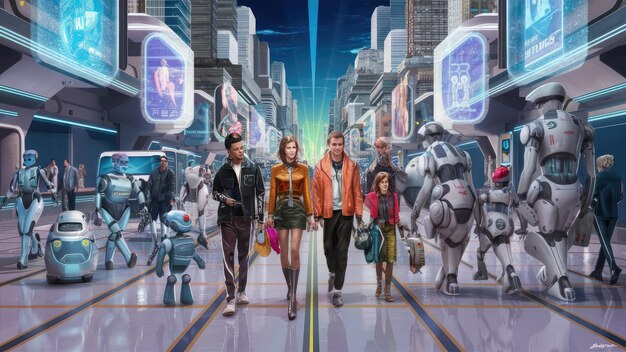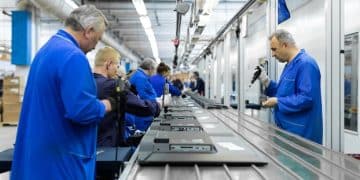AI Automation Transforming US Job Roles by 2025?

AI-powered automation is expected to significantly reshape US job roles by 2025, leading to both job displacement in some sectors and the creation of new, specialized positions requiring advanced skills in areas like AI maintenance, data analysis, and human-machine collaboration.
The landscape of employment in the United States is on the cusp of a major transformation. As we approach 2025, the integration of AI-powered automation is poised to profoundly reshape job roles across various sectors. This article explores the potential impacts, challenges, and opportunities that this technological shift presents for the American workforce.
The Rise of AI and Automation in the US Workforce
Artificial intelligence (AI) and automation are no longer futuristic concepts; they are rapidly becoming integral parts of the US workforce. Businesses are increasingly adopting AI-driven solutions to improve efficiency, reduce costs, and enhance productivity. This technological wave is set to disrupt traditional job roles and create new demands for specialized skills.
Understanding the scope and implications of AI-powered automation is crucial for businesses, policymakers, and individuals alike. This transformative force will not only alter the types of jobs available but also the skills required to thrive in the evolving labor market.
The Current State of Automation
Before delving into the future, it’s important to assess the current state of automation in the US. Several industries have already seen significant automation, including manufacturing, logistics, and customer service. These sectors have experienced increased efficiency and output through the integration of robotic systems and AI-driven software.
- Manufacturing: Automation has streamlined production processes, reducing reliance on manual labor.
- Logistics: AI-powered systems optimize supply chains, improving delivery times and reducing costs.
- Customer Service: Chatbots and AI assistants handle routine inquiries, freeing up human agents for complex issues.
While automation has brought numerous benefits, it has also raised concerns about job displacement and the need for workforce retraining. Addressing these challenges proactively is essential to ensure a smooth transition into the future of work.
In conclusion, the rise of AI and automation is transforming the US workforce, driving changes across various industries. Understanding this evolving landscape is crucial for businesses and individuals looking to adapt and thrive in the future.
Job Displacement and Creation: A Dual Impact
The integration of AI-powered automation presents a dual impact on the US job market: the displacement of some jobs and the creation of others. While certain roles may become obsolete due to automation, new opportunities will emerge in areas related to AI development, maintenance, and human-machine collaboration.
Analyzing these trends is essential for understanding the net effect of automation on employment and identifying strategies for mitigating potential negative consequences.

Sectors at Risk of Job Displacement
Several sectors are particularly vulnerable to job displacement due to AI-powered automation. These include roles that involve repetitive tasks, data processing, and manual labor. Understanding which jobs are most at risk can help workers prepare for the future by acquiring new skills.
- Data Entry: AI can automate data processing tasks, reducing the need for human data entry clerks.
- Manufacturing Assembly Line Workers: Robots and automated systems can perform assembly line tasks more efficiently than humans.
- Truck Drivers: Self-driving trucks could replace human drivers in the long term.
While some of these jobs may not disappear entirely, the demand for them is likely to decrease significantly. Workers in these roles may need to consider retraining or transitioning to new careers.
Emerging Job Opportunities
Alongside job displacement, AI-powered automation will also create new job opportunities. These emerging roles will require specialized skills in areas such as AI development, data analysis, and human-machine collaboration. Preparing for these new opportunities is crucial for ensuring a skilled workforce.
- AI Developers: Designing, building, and maintaining AI systems.
- Data Scientists: Analyzing and interpreting large datasets to drive business decisions.
- Robotics Maintenance Technicians: Ensuring the smooth operation of robotic systems and automated machinery.
Furthermore, there will be a growing need for professionals who can bridge the gap between humans and machines, such as AI trainers, explainable AI specialists and ethicists, and human-machine interface designers. These roles will require a combination of technical expertise and soft skills.
In conclusion, the impact of AI-powered automation on the US job market will be twofold, leading to both job displacement and creation. Understanding these trends is essential for businesses and policymakers to prepare for the future and equip the workforce with the necessary skills.
The Skills Gap: Preparing the Workforce for AI
One of the biggest challenges posed by AI-powered automation is the skills gap. The existing workforce may lack the necessary skills to thrive in the new job market. Addressing this gap through education, training, and upskilling initiatives is crucial for ensuring a smooth transition.
Exploring the skills needed for the future and strategies for acquiring them is essential for empowering workers and businesses alike.

Identifying Critical Skills
As AI and automation become more prevalent, certain skills will become increasingly valuable in the job market. These include technical skills, such as programming and data analysis, as well as soft skills, such as critical thinking, problem-solving, and creativity.
- Programming: Proficiency in languages such as Python, Java, and C++.
- Data Analysis: Ability to collect, analyze, and interpret data to derive insights.
- Critical Thinking: Evaluating information and making reasoned judgments.
In addition to these core skills, adaptability, communication, and collaboration will be essential for workers to thrive in a rapidly changing environment.
Closing the Skills Gap
Closing the skills gap requires a multi-faceted approach involving education, training, and lifelong learning. Educational institutions, businesses, and government agencies must collaborate to provide workers with the skills they need to succeed.
- Education Reform: Integrating AI and technology-related topics into school curricula.
- Vocational Training Programs: Providing hands-on training in high-demand skills.
- Upskilling and Reskilling Initiatives: Offering opportunities for workers to acquire new skills throughout their careers.
Furthermore, online learning platforms and micro-credentialing programs can provide flexible and accessible training options for workers who need to upskill quickly.
In conclusion, addressing the skills gap is crucial for preparing the US workforce for the challenges and opportunities presented by AI-powered automation. By investing in education, training, and lifelong learning, the nation can foster a skilled workforce that is ready to thrive in the future.
The Role of Government and Policy
Government and policy play a critical role in shaping the impact of AI-powered automation on the US job market. Policymakers must develop strategies to mitigate job displacement, support workforce retraining, and ensure that the benefits of AI are shared broadly.
Examining the policy options available and their potential impact is essential for creating a fair and equitable future of work.
Mitigating Job Displacement
One of the primary concerns related to AI-powered automation is job displacement. Policymakers can implement measures to mitigate this impact, such as providing unemployment benefits, offering job search assistance, and investing in retraining programs.
Additionally, policies that promote job creation in emerging sectors can help offset job losses in traditional industries. These may include tax incentives for businesses that invest in AI development and support for entrepreneurs who are launching AI-related startups.
It’s important to notice that focusing on the benefits of tech is crucial for long term adoption in the states.
Supporting Workforce Retraining
Workforce retraining is essential for helping workers transition to new jobs in the AI-driven economy. Policymakers can support retraining programs through funding, partnerships with educational institutions, and incentives for businesses that offer training to their employees.
- Funding: Allocating resources to support retraining programs and scholarships.
- Partnerships: Collaborating with educational institutions to create relevant training courses.
- Incentives: Providing tax breaks or grants for businesses that invest in employee training.
Furthermore, policymakers can encourage lifelong learning by promoting initiatives such as online learning platforms and micro-credentialing programs.
Ensuring Equitable Benefits
To foster the benefits of AI, the government should look into investing in social security to allow for universal basic income.
- AI access to the public: Ensuring that there will be AI access for every individual.
- Equal training opportunities: Making sure people have equal opportunity to learn.
In conclusion, government and policy play a crucial role in managing the impact of AI-powered automation on the US job market. By implementing proactive measures, such as mitigating job displacement, supporting workforce retraining, and ensuring equitable benefits, policymakers can help create a future of work that is both prosperous and inclusive.
The Ethical Considerations of AI in the Workplace
As AI becomes more pervasive in the workplace, ethical considerations are essential. Issues such as bias, transparency, and privacy must be addressed to ensure that AI systems are used responsibly and ethically.
Exploring these ethical considerations and developing guidelines for AI development and deployment is essential for building trust and ensuring fairness.
Addressing Bias
AI systems can perpetuate and amplify existing biases if they are trained on biased data. Addressing bias in AI requires careful data collection, algorithm design, and ongoing monitoring to ensure fairness.
- Data Collection: Ensuring that training data is representative of the population and free from bias.
- Algorithm Design: Developing algorithms that are fair and unbiased.
- Ongoing Monitoring: Regularly auditing AI systems to identify and address bias.
Furthermore, transparency and explainability can help users understand how AI systems make decisions and identify potential sources of bias.
Ensuring Transparency
Transparency in AI systems is essential for building trust and ensuring accountability. Users should be able to understand how AI systems work, how they make decisions, and what data they use.
- Explainable AI: Developing AI systems that can explain their decisions in a clear and understandable way.
- Documentation: Providing comprehensive documentation about AI systems, including their design, training data, and performance.
Furthermore, AI systems should be subject to external audits and reviews to ensure that they are transparent and accountable.
Protecting Privacy
AI systems often collect and process large amounts of personal data, raising concerns about privacy. Protecting privacy in the age of AI requires implementing robust data protection measures, such as encryption, anonymization, and access controls.
- Encryption: Protecting data from unauthorized access by encrypting it.
- Anonymization: Removing personally identifiable information from data.
- Access Controls: Limiting access to data to authorized personnel only.
Furthermore, individuals should have the right to access, correct, and delete their personal data, as well as the right to opt out of data collection.
In conclusion, ethical considerations are crucial for ensuring that AI is used responsibly and ethically in the workplace. By addressing issues such as bias, transparency, and privacy, businesses can build trust and create a future of work that is both innovative and ethical.
Industry-Specific Impacts of AI Automation
The impact of AI Automation will vary across different industries, from healthcare to finance, each sector will experience its unique set of challenges and opportunities.
Healthcare
AI powered diagnostics tools, automated surgery, and personalized treatment plans will create a need for specialized jobs.
- AI driven diagnosis: AI can help doctors diagnose patients more accurately and quickly, saving lives and improving outcomes.
- Customized treatment plans: AI can analyze patient data to recommend personalized treatment plans that are more effective.
Finance
Fraud detection, algorithmic trading, and personalized financial advice will be enhanced.
- Personalized assistance: AI can provide customized service to clients, leading to better financial outcomes.
- Fraud Detection: Algorithms can detect and prevent potential fraud.
Education
Customized learning programs, and automated grading systems.
- Customized learning : AI can adapt to each student’s learning style and needs, making education more effective.
- Simplified administration: AI can help teachers focus on students while AI focuses on taking care of the administration tasks.
To conclude, exploring these ethical considerations, and applying guidelines will allow us to create trust.
Preparing for the Future: Strategies for Individuals and Businesses
To flourish, preparing individuals for the future, and helping companies adapt to these changes is crucial.
Strategies for Individuals
- Continuous Learning: Lifelong learning attitudes will allow for constant improvements.
- Focus on soft skills: Soft skills have increased in importance due to the need for interpersonal connections.
Strategies for Businesses
- Create strategic job plans: Invest in a plan to take advantage of the new automation tools.
- Always upskill: Companies should invest in up skilling programs.
In conclusion, ethical considerations are crucial for ensuring that AI is used responsibly and ethically in the workplace. By addressing issues such as bias, transparency, and privacy, businesses can build trust and create a future of work that is both innovative and ethical.
| Key Point | Brief Description |
|---|---|
| 🤖 Job Displacement | Automation may replace repetitive tasks, impacting data entry and manufacturing roles. |
| 💼 Emerging Opportunities | AI will create new roles in AI development, data analysis, and robotics maintenance. |
| 📚 Skills Gap | Workforce requires upskilling in programming, data analysis, and critical thinking. |
| ⚖️ Ethical Considerations | Bias, transparency, and privacy must be addressed in AI deployment. |
FAQ Section
▼
AI automation can lead to job displacement in some sectors but also creates new opportunities requiring advanced skills in AI maintenance, data analysis, and human-machine collaboration.
▼
Sectors involving repetitive tasks and manual labor such as manufacturing, data entry, and transportation are particularly vulnerable to job displacement.
▼
Technical skills like programming and data analysis, and soft skills such as critical thinking, problem-solving, creativity, and effective communication are essential.
▼
Governments can invest in retraining programs, provide unemployment benefits, support job search assistance, and incentivize entrepreneurship in AI-related sectors to help.
▼
It’s crucial to address potential biases, ensure transparent decision-making processes, protect privacy, and implement strict data protection measures in AI deployment to maintain fairness and trust.
Conclusion
As we approach 2025, AI-powered automation will undoubtedly continue to reshape US job roles. While challenges such as job displacement and skills gaps exist, proactive measures, including education, training, reskilling initiatives, and ethical guidelines, can ensure a smooth transition and unlock the full potential of AI for the benefit of the American workforce. Embracing these changes with a forward-thinking approach will pave the way for a future where humans and AI collaborate to drive innovation and economic growth.





